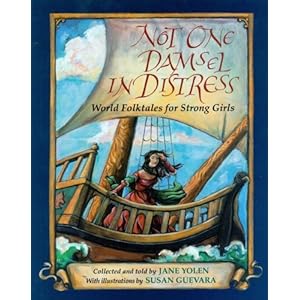Three Clever Mice
Folktales retold and adapted by Gerda Mantinband
Illustrated by Martine Gourbault
1st -3rd Graders
4/5 ****
I really enjoyed this book; it is not a traditional fairy tale, but it has three fun short tales in it about 3 mice. Although it does not directly relate to the better-known tale of the 3 blind mice, it could easily be compared and contrasted to that story as well.
 One thing that I thought was very interesting about this book, was the common motif or trend of the number “3”. There were often 3 tasks, 3 mice, 3 potential mates, 3 sons etc… There were almost always 3 of whatever was going on in each of the stories. I think this would be a good way to help summarize the book at the end, instead of writing a summary to list all of the sets of 3s students could remember from the book. Another great literary element was the repetitive phrases. Especially in the first tale, the main character would repeat the same phrases over and over throughout the book. This is a great and very helpful aspect when working with beginning readers.
One thing that I thought was very interesting about this book, was the common motif or trend of the number “3”. There were often 3 tasks, 3 mice, 3 potential mates, 3 sons etc… There were almost always 3 of whatever was going on in each of the stories. I think this would be a good way to help summarize the book at the end, instead of writing a summary to list all of the sets of 3s students could remember from the book. Another great literary element was the repetitive phrases. Especially in the first tale, the main character would repeat the same phrases over and over throughout the book. This is a great and very helpful aspect when working with beginning readers. I felt like the stories were very predictable, and they had an almost singsong feel to them. They were not poetic, but I think because they were so predictable they flowed very well. The pictures were great; they gave some added details that the text did not necessarily spell out, so that is always a great aspect of picture books for beginning readers.
In addition to these literary elements, I think that the stories teach some great lessons. Although that is not always the first thing to look for when looking for quality literature, I think it is important, and is a great way to generate theme discussions and relate the stories to students’ personal lives.
Not one Damsel in Distress: World folktales for Strong Girls
Collected and told by Jane Yolen
Illustrations by Susan Guevara
4th-5th Graders
5/5 *****
This is a collection of short stories, and the stories do not include the typical fairy tale princess who needs a prince to save her. They are quite the opposite. There are stories from all different countries from around the world, each with a female heroine. I really enjoyed this book; as the daughter of a strong feminist mother, I think I am slightly biased towards it. This is great book that gives a (more admirable) female perspective to the fairy tale world.
There is a lot of dialogue in many of the stories in this book, so it is a great way to introduce using dialogue in stories students are working on. It is also a great way to introduce new cultures, different values and other countries in social studies or geography lessons. Including diversity in the classroom is such an important thing to do these days, and this books gives so many opportunities to do so.
The stories in this book have a common structure. Instead of having numbered or titled chapters, Yolen uses a different style font for the first few words of a new section, as well as leaving a blank line in between parts. I think this is important to note, and to show students yet another way of structuring and organizing a story.

No comments:
Post a Comment